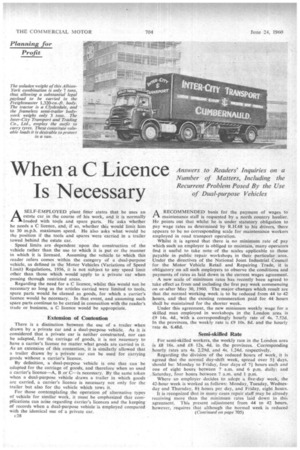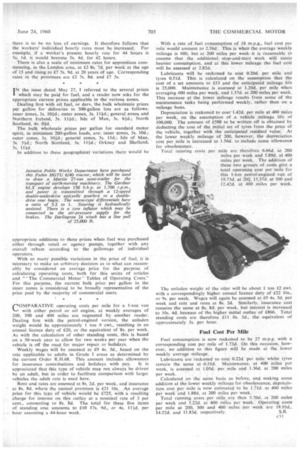When a C Licence Is Necessary
Page 66

Page 69

If you've noticed an error in this article please click here to report it so we can fix it.
ASELF-EMPLOYED plant fitter states that he uses an estate car in the course of his work, and it is normally loaded with tools and spare parts. He asks whether he needs a C licence, and, if so, whether this would limit him to 30 m.p.h. maximum speed. He also asks what would be the position if the tools and spares were carried in a trailer towed behind the estate car.
Speed limits are dependent upon the construction of the vehicle rather than the use to which it is put or the manner in which it is licensed. Assuming the vehicle to which this reader refers comes within the category of a dual-purpose vehicle, as defined in the Motor Vehicles (Variations of Speed Limit) Regulations, 1956, it is not subject to any speed limit other than those which would apply to a private car when passing through restricted areas.
Regarding the need for a C licence, whilst this would not be necessary so long as the articles carried were limited to tools, spare parts would be classed as goods, for which a carrier's licence would be necessary. In that event, and assuming such spare parts continue to be carried in connection with the reader's trade or business, a C licence would be appropriate.
Extension of Contention There is a distinction between the use of a trailer when drawn by a private car and a dual-purpose vehicle. As it is considered that a private car is neither constructed, nor can be adapted, for the carriage of goods, it is not necessary to have a carrier's licence no matter what goods are carried in it. As an extension of this contention, it is similarly allowed that a trailer drawn by a private car can be used for carrying goods without a carrier's licence.
By definition, a dual-purpose vehicle is one that can be adapted for the carriage of goods, and therefore when so used a carrier's licence—A, B or C—is necessary. By the same token when a dual-purpose vehicle draws a trailer in which goods arc carried, a carrier's licence is necessary not only for the trailer but also for the vehicle which tows it.
For those contemplating the operation of alternative types of vehicle for similar work, it must be emphasized that complications can arise regarding carrier's licences and the keeping of records when a dual-purpose vehicle is employed compared with the identical use of a private car.
c28
ARECOMMENDED basis for the payment of wages to maintenance staff is requested by a north country haulier. He points out that whilst he is under statutory obligation to pay wage rates as determined by R.H.68 to his drivers, there appears to be no corresponding scale for maintenance workers employed in road transport operation.
Whilst it is agreed that there is no minimum rate of pay which such an employer is obliged to maintain, many operators find it useful to take note of the scales applicable to those payable in public repair workshops in their particular area. Under the directives of the National Joint Industrial Council for the Motor Vehicle Retail and Repairing Trade, it is obligatory on all such employers to observe the conditions and payments of rates as laid down in the current wages agreement.
A new scale of minimum rates has recently been agreed to take effect as from and including the first pay week commencing on or after May 30, 1960. The major changes which result are that the normal working week is to be 'educed from 44 to 42 hours, and that the existing remuneration paid for 44 hours shall be maintained for the shorter week.
Under this agreement, the new minimum weekly wage for a skilled man employed in workshops in the London area is £9 14s. 4d., with a correspondingly hourly rate of 4s. 7.52d. In the provinces, the weekly rate is £9 10s. 8d. and the hourly rate 4s. 6.48d.
Semi-skilled Rate
For semi-skilled workers, the weekly rate in the London area is £8 16s. and £8 12s. 4d. in the provinces. Corresponding hourly rates are 4s. 2.29d. and 4s. 1.24d. respectively.
Regarding the division of the reduced hours of work, it is agreed that the normal day-shift week, spread over 5+ days, should be: Monday to Friday, four days of 71 hours each and one of eight hours between 7 a.m. and 6 p.m. daily; and Saturday, four hours between 7 a.m. and 1 p.m.
Where an employer decides to adopt a five-day week, the 42-hour week is worked as follows: Monday, Tuesday, Wednesday and Thursday, 8+ hours per day, and Friday, eight hours.
It is recognized that in many cases repair staff may be already receiving more than the minimum rates laid down in this agreement. This present adjustment from 44 to 42 hours, however, requires that although the normal week is reduced there is to be no loss of earnings. It therefore follows that the workers' individual hourly rates must he increased. For example, if a worker's present hourly rate for 44 hours is 5s. Id. it would become 5s. 4d. for 42 hours.
There is also a scale of minimum rates for apprentices commencing, in the London area, at £2 8s. 7d. per week at the age of 15 and rising to £7 5s. 9d. at 20 years of age. Corresponding rates in the provinces are £2 7s. 8d. and £7 3s.
I N the issue dated May 27, I referred to the several prices
which may be paid for fuel, and a reader now asks for the appropriate current prices applicable in the various zones.
Dealing first with oil fuel, or derv, the bulk wholesale prices per gallon for deliveries in 500-gallon lots are as follows: inner zones, 3s. 10fd.: outer zones, 3s. 1 lid.; general zones and Northern Ireland, 3s. I Ifd.; Isle of Man, 3s. 61d.; North Scotland, 4s. Old.
The bulk wholesale prices per gallon for standard motor spirit, in minimum 200-gallon loads, are: inner zones, 3s. 10d.; outer zones, 3s, 100.; general zones, 3s. lid.; Isle of Man, .3s. 5fd.; North Scotland, 3s, I Ifd.; Orkney and Shetland, 3s. llfd.
In addition to these geographical variations there would be appropriate additions to these prices when fuel was purchased either through retail or agency pumps, together with any overall rebate according to the gallonage of individual operators,
With so many poSsible variations in the price of fuel, it is necessary to make an arbitrary decision as to what can reasonably he considered an average price for the purpose of calculating operating costs, both for this series of articles and " ' The Commercial Motor' Tables of Operating Costs.For this purpose, the current bulk price per gallon in the inner zones is considered to be broadly representative of the price paid by the majority of commercial users.
COMPARATIVE operating costs per mile for a I-ton van with either petrol or oil engine, at weekly averages of 200, 300 and 400 miles are requested by another reader. Dealing first with the petrol-engined version, the unladen weight would be approximately l ton 9 cwt., resulting in an annual licence duty of £20, or the equivalent of 8s. per week. As with the calculation of other standing costs, this is based on a 50-week year to allow for two weeks per year when the vehicle is off the road for major repair or holidays.
Weekly wages will be assessed at £9 4s. 3d., based on the rate applicable to adults in Grade I areas as determined by the current Order R.F1,68. This amount includes allowances for insurance contributions and holidays with pay. It is appreciated that this type of vehicle may not always be driven by an adult, but in order to facilitate comparison with target vehicles the adult rate is used here.
Rent and rates are assessed at 8s. 2d. per week, and insurance at 8s. 8d. where the annual premium is £21 10s. An average price for this type of vehicle would be £725, with a resulting charge for interest on this outlay at a nominal rate of 3 per cent., amounting to 8s. 8d. The total for these five items of standing cost amounts to £10 17s. 9d., or 4s. 1 1 Id. per hour assuming a 44-hour week. With a rate of fuel consumption of 18 m.p.g.. fuel cost per mile would amount to 2.56d. This is when the average weekly mileage is 400, but at 200 miles per week it is reasonable to assume that the additional stop-and-start work will cause heavier consumption, and at this lower mileage the fuel cost will be assessed at 2.82d.
Lubricants will be reckoned to cost 0.20d. per mile and tyres 0.51d. This is calculated on the assumption that the cost of a set amounts to £53 and the anticipated mileage life is 25,000. Maintenance is assessed at 1.20d. per mile when averaging 400 miles per week, and 1.57d. at 200 miles per week. This increase at the lower mileage results from some of the maintenance tasks being performed weekly, rather than on a mileage basis.
Depreciation is reckoned to cost 1.42d. per mile at 400 miles per week, on the assumption of A vehicle mileage life of 100,000. The amount of £588 to be written off is obtained by deducting the cost of the initial set of tyres from the price of the vehicle, together with the anticipated residual value: At the lower weekly mileage of 200, however, the depreciation cost per mile is increased to 1.56d, to include some allowance for obsolescence.
• Total running costs per mile are therefore 6.66d. at 200 miles per week and 5.89d. at 400 miles per week. The addition of these two groups of costs give a total operating cost per mile for this 1-ton petrol-engined van of 19.73d. at 2011,, 15.37d. at 300 and 12.42d. at 400 miles per week.
The unladen weight of the oiler will be about 1 ton 12 cwt. with a correspondingly higher annual licence duty of £22 10s.. or 9s, per week. Wages will again be assessed at £9 4s. 3d. per week and rent and rates at 8s. 2d, Similarly, insurance cost remains the same at 8s. 8d, per week, but interest is increased to 10s. 4d. because of the higher initial outlay of £866. Total standing costs are therefore £11 Os. 5d., the equivalent of approximately 5s. per hour.
Fuel Cost Per Mile
Fuel consumption is now reckoned to be 27 m.p.g. with a corresponding cost per mile of 1.73d. On this occasion, however, no addition to this figure will be made at the lower weekly average mileage.
Lubricants are reckoned to cost 0.22d. per mile whilst tyres remain the same at .0.51d. Maintenance, at 400 miles per week, is assessed at 1.05d. per mile and 1.36d. at 200 miles
per week. . .
Calculated on the same basis as before, and making some addition at the lower weekly mileage for obsolescence, depreciation cost per mile is now estimated to be 1.71d. at 400 miles per week and 1.88d, at 200 miles per week.
Total running costs per Mile are then 5.70d. at 200 miles per week and 5.22d. at 400 miles per week. Operating costs per mile at 200, 300 and 400 miles per week are 18.93d..
14.52d. and 11.83d. respectively. S. B.












































































































